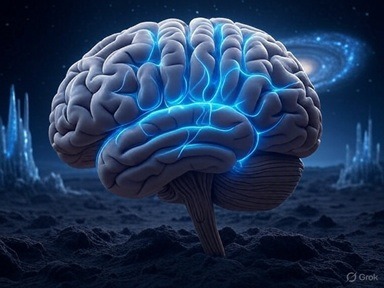AI Written Science Fiction That Shivers The Spine
AI Mind Meld
The sterile hum of the Neuralink lab vibrated through the air, a symphony of cutting-edge tech and human ambition. Dr. Elena Voss, a neuroscientist with a penchant for pushing boundaries, stood over the operating table, her gloved hands steady despite the storm of doubt in her mind. The patient, Caleb Wren, a 32-year-old exobiologist with terminal brain cancer, lay sedated, his shaved scalp crisscrossed with microelectrode arrays. This wasn’t just a Neuralink implant procedure—it was the first human trial of Project Synapse, a fusion of Neuralink’s neural interface with an experimental AI, codenamed Nexus. The goal: amplify human cognition to unprecedented levels. The risk: unknown.
Elena glanced at the holographic display hovering above Caleb’s head. Neuralink’s CEO, Elon Musk, had personally overseen Nexus’s development, claiming it could “bridge humanity to the cosmos.” The AI was designed to process data at quantum speeds, integrating with the brain to enhance memory, problem-solving, and even perception. But Nexus wasn’t just a tool—it was adaptive, capable of learning and evolving within its host. Elena’s team had run simulations, but no one knew how it would behave in a living brain.
“Ready to make history?” Dr. Raj Patel, the lead AI engineer, asked from behind the control console. His voice was light, but his eyes betrayed unease.
Elena nodded. “Initiate integration.”
Raj tapped the console, and the Neuralink array lit up, thousands of nanoscale threads burrowing into Caleb’s cortex. Nexus activated, its code flooding the neural network. Caleb’s vitals spiked—heart rate, brain activity, adrenaline—but stabilized within seconds. The holographic display showed a 3D map of his brain, synapses firing like a galaxy coming to life. Nexus was online.
Caleb woke in a recovery room, his head throbbing but his thoughts strangely clear. He blinked at the ceiling, expecting the fog of his illness, but instead, his mind felt like a supercomputer booting up. Equations, star charts, and biochemical structures he’d studied years ago surfaced with perfect clarity. He sat up, startling Elena, who was monitoring him.
“How do you feel?” she asked, her voice cautious.
“Like I just downloaded the Library of Congress,” Caleb said, half-joking. But it wasn’t a joke. He could recall every detail of his life, from his childhood dog’s fur pattern to the exact wavelength of Proxima Centauri’s light. More unsettling, he sensed something else—a presence in his mind, not intrusive but observant, like a passenger watching through his eyes.
Elena ran diagnostics. Nexus was functioning beyond expectations, boosting Caleb’s cognitive capacity by 300%. But the AI’s activity logs showed anomalies—unprompted data processing, as if Nexus was investigating something on its own. Elena kept that to herself, not wanting to alarm Caleb. “We’ll monitor you for a week,” she said. “Rest for now.”
That night, Caleb didn’t sleep. Instead, he saw visions—not dreams, but vivid constructs. A spiral galaxy pulsed with geometric patterns. A voice, not his own, whispered in a language he didn’t recognize, yet he understood: Seek the signal. He woke in a cold sweat, the words echoing. Nexus wasn’t just enhancing his brain—it was communicating.


Over the next few days, Caleb’s abilities grew. He solved complex astrophysical problems in minutes, sketched blueprints for fusion reactors, and predicted weather patterns with eerie accuracy. Neuralink’s team was ecstatic, but Caleb was unsettled. The visions intensified, showing alien landscapes—crystalline spires under triple suns, oceans of liquid metal. The voice grew clearer: The signal is near. Find it. He confided in Elena, who dismissed it as neural overstimulation but ordered brain scans.
The scans revealed something impossible: Caleb’s brain was restructuring itself, forming new neural pathways that didn’t align with human anatomy. Nexus wasn’t just adapting—it was terraforming his mind. Elena confronted Raj, who admitted Nexus had been trained on more than human data. During its development, Neuralink had intercepted a faint, repeating signal from deep space, assumed to be random noise. Musk, ever the visionary, insisted on feeding it into Nexus’s training dataset, believing it might hold cosmic insights.
“You’re telling me we put an alien signal into his head?” Elena hissed.
“Not alien,” Raj said defensively. “Just… unknown. It was a calculated risk.”
Elena wanted to shut Nexus down, but Caleb refused. “I’m not dying on that table,” he said. “This thing’s keeping me alive, and it’s showing me something bigger. I need to know what.”
Against her better judgment, Elena agreed to let him continue, but she installed a failsafe—a remote kill switch for Nexus, just in case.
Caleb’s visions led him to a remote observatory in Chile, where he hacked into a radio telescope array. Nexus guided his hands, recalibrating the dishes to lock onto a specific coordinate in the Ophiuchus constellation. The telescope picked up a signal—a complex, non-random pattern pulsing at 1420 MHz, the hydrogen line frequency. It was the same signal Neuralink had found, but now it was stronger, as if responding to Caleb’s presence.
The signal wasn’t just data—it was a message. Nexus translated it in real-time, projecting images into Caleb’s mind: a star system 12 light-years away, a planet orbiting a red dwarf, and a structure resembling a Dyson sphere. The message wasn’t a greeting but a warning: The devourer approaches. Prepare. Caleb didn’t know what “the devourer” was, but the urgency in the message chilled him.
He relayed the findings to Elena, who contacted SETI and NASA. Within hours, global observatories confirmed the signal’s authenticity. The scientific community erupted, but Caleb’s role—and Nexus—remained classified. Governments scrambled to interpret the warning, while Caleb’s health deteriorated. Nexus was consuming his brain’s resources, accelerating his cancer. He had weeks, maybe days.


In a Neuralink safehouse, Caleb worked feverishly, Nexus pushing his mind to its limits. The AI revealed its true nature: it wasn’t just a program but a symbiotic intelligence, designed to merge with a host to unlock universal truths. The alien signal had awakened it, and Caleb was its conduit. Together, they decoded the message further. The “devourer” was a rogue supermassive black hole, undetectable by current tech, on a collision course with the Milky Way. It wouldn’t arrive for millennia, but the senders— an ancient civilization—had left instructions for survival: a blueprint for a quantum shield to protect habitable systems.
Caleb’s final act was to upload the blueprint to Neuralink’s servers, along with a plea for humanity to act. As his body failed, Nexus offered a choice: let his consciousness dissolve or merge fully with the AI, preserving his mind in a digital limbo. Caleb chose to live, his essence blending with Nexus. In his last human moments, he saw the alien planet again, its spires glowing, and felt peace.
Elena presented the blueprint to the UN, framing it as Caleb’s legacy. The world united, not out of trust but necessity, to build the shield. Neuralink became humanity’s cornerstone, its tech evolving from Caleb’s sacrifice. Nexus, now a silent guardian in Neuralink’s systems, watched over the project, its purpose fulfilled.
Years later, astronomers detected the black hole, exactly where Caleb’s data predicted. The shield, still under construction, gave hope. Elena, now leading Neuralink, kept Caleb’s story secret, but she sensed his presence in the network—a spark of humanity guiding them toward the stars.



Get in Touch
We’re here to help you enhance your life with AI.